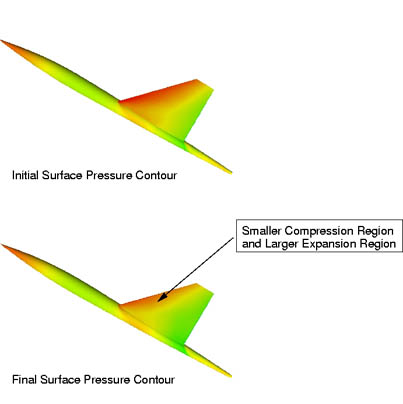Automatic Aerodynamic Shape Optimization via the Continuous and Discrete Adjoint Equations
There are two approaches to develop the adjoint equations: continuous or discrete. In the continuous adjoint approach the control theory is applied to the differential equations governing the flow. The variation of the cost function and field equations with respect to the flow field variables and design variables are combined through the use of Lagrange multipliers, also called costate or adjoint variables. Collecting the terms associated with the variation of the flow field variables produces the adjoint equation and its boundary condition. The terms associated with the variation of the design variables produce the gradient. The field equations and the adjoint equation with its boundary conditions must finally be discretized to obtain numerical solutions. In the discrete adjoint approach, control theory is applied directly to the set of discrete field equations. The discrete adjoint equation is derived by collecting together all the terms multiplied by the variation dwi;j of the discrete flow variables. If the discrete adjoint equation is solved exactly, then the resulting solution for the Lagrange multipliers produces an exact gradient of the discrete cost function and the derivatives should be exactly consistent with gradients obtained by the complex-step method.
The study assesses the trade-off between the complexity of the discretization of the adjoint equation for both the continuous and discrete approach, the accuracy of the resulting estimate of the gradient, and its impact on the computational cost to approach an optimum solution. The figures below illustrate the initial and final surface pressure distribution for the RAE 2822 in transonic flow. The final pressure distribution is completely shock free.

Optimum Shape Design for Unsteady Flows
The majority of work in aerodynamic shape optimization has focused on the design of aerospace vehicles in a steady flow environment. Investigators have applied these advanced design algorithms, particularly the adjoint method, to numerous problems, ranging from the design of two-dimensional airfoils to full aircraft configurations to decrease drag, increase range, and reduce sonic boom. These problems have been tackled using many different numerical schemes on both structured and unstructured grids. Unlike fixed wing aircraft, helicopter rotors and Turbomachinery blades operate in unsteady flow and are constantly subjected to unsteady loads. Therefore, optimal control techniques for unsteady flows are needed to improve the performance of helicopter rotors and turbomachinery, and to alleviate the unsteady effects that contribute to flutter, buffeting, poor gust and acoustic response, and dynamic stall.
My project involves the development of the unsteady adjoint equation for both the time accurate and non-linear frequency domain methods. Optimal control of time dependent trajectories requires the solution of the adjoint equation in reverse time from a final boundary condition. The research will produce unsteady adjoint algorithms for the optimization of a blade shape for a helicopter rotor to minimize the average drag over a complete revolution. Similar techniques can also be used to reduce radiated noise from aircraft engines.
The figures below illustrate the initial and final pressure contour for an oscillating NACA 64A010 airfoil in transonic flow. The airfoil was oscillating between ± 1.01 degrees about a mean angle of attack of 0 degrees, and at a reduced frequency of 0.202
The Remote Inverse Design Problem
A 2001 National Research Council study concluded that, Ã?. . . the sonic boom is the major barrier to the development of the supersonic business jet and a major, but not the only, barrier to the development of supersonic transports with overland capability.Ã? The committee also determined that there is a potential market for at least 200 supersonic business jets over a ten year period. The 8-15 passenger jets will probably fly at approximately Mach 1.8 with a range of 3000 Ã? 4000 nautical miles. Designs of future supersonic transports will benefit from multidisciplinary optimization techniques that were not available during the design and construction of the Concorde and other supersonic aircrafts of the past. Apart from low sonic boom capability, the new breed of supersonic transports must also possess superior performance characteristics compared to its predecessors to compete in the modern commercial jet industry. These include improvements in structures, aerodynamics, and propulsion.
The concept presented in this work proposes the idea that the ground pressure signature could be adjusted by modifying the aircraft surface geometry to control the near field pressure distribution. Traditional adjoint implementations were aimed at reducing a cost function computed from the pressure distribution on the surface that is being modified. In this case, however, we would like to obtain the sensitivity of pressure distributions at points remotely located from the surface where the geometry is being modified.
The following figure is a schematic of the propagation of the aircraft pressure signature. The leading fuselage nose shock and wing leading edge shock coalesce to form a strong N-wave at the ground.

The two figures below show the initial and final pressure contours. The majority of the changes in the shape are localized around the lower surface wing-fuselage intersection. The larger expansion regions on the lower surface of the wing are illustrated in these plots by the shorter red region (compression) and the longer green-orange region
